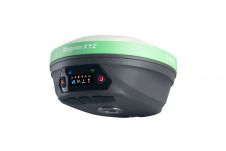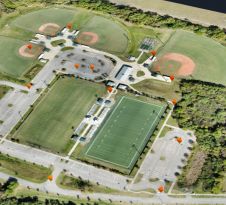Development of the ILRIS-36D
Balancing User, Market and Design Objectives
The ILRIS-3D laser scanner was launched in 1999 as a measuring system for 3D-point cloud collection. In October 2004 Optech launched its second-generation, tripod-mounted laser scanner, the ILRIS-36D. But getting the new design to meet the sometimes conflicting objectives of end user, laser scanning market and internal design team proved a challenge. The author offers insight into design decisions and driving factors for developing the scanner.
The design of the new ILRIS laser scanner began with three questions.
- How to provide a scanner that makes good business sense for its owner?
- How to improve the scanner technically while maintaining focus on core market and preserving the characteristics of the original?
- How to accomplish the first two objectives while remaining fiscally responsible and on schedule for the product release?
To find answers, interviews were conducted among ILRIS distributors, users, engineers and sales staff. Non-ILRIS users - selected industry insiders and software developers for the industry - were also approached because such insiders can provide a unique perspective based on an unbiased opinion. The interviews revealed that at business level users wanted the manufacturer to demonstrate a sound business case. Businesses also required innovative design to be compatible with their existing technology. It emerged that at feature level the Field Of View (FOV) of ILRIS-3D, 40ºx40º and its fixed tripod base limited the scanner's ability to support large surveys. Although aligning multiple scans via PolyWorks or similar post-processing software is common in large surveys a limited FOV requires setting up of the scanner several times and complicates post-processing. Consequently, the trend in the tripod-mounted laser scanner market is towards providing scanners that collect data on a 360° axis.
Product Versatility
The first question potential users ask before purchasing is, what is my Return On Investment (ROI))? The factors that affect scanner ability to maximise ROI include:
- capability: how efficiently does the scanner meet user needs?
- versatility: how many applications can the scanner be used for?
- lifecycle: how long will the user be competitive with the scanner?
Market research showed one of the biggest concerns was the timeline for the release of a new model. Purchasing a laser scanner requires a large investment in time, money and labour. So companies do not want a few months after purchase to find that a new model has come out. This gives their competitors an advantage and leaves them out in the cold with a scanner that is out of date and hard to upgrade.
Since a single application may not keep the scanner busy 100% of the time, users naturally look for a versatile product: if the scanner is not being used on project A it can be used on project B. But project characteristics may differ completely from one to another. For example, project A may involve scanning a bridge requiring a 100m maximum range and 7mm accuracy, whilst project B may involve surveying an open-caste quarry requiring 1,000m range and 50mm accuracy.
Keeping Up-to-date
With this in mind, two concepts came out of the very first design meeting; the new scanner should be backwards-compatible and modular, paving the way for new features without changing the entire system. Backwards compatibility is important for two reasons: to protect the investment of current ILRIS owners and to maintain Optech's focus on supporting its clients over the long term. Backwards compatibility also reassures new users that a scanner bought today will not be obsolete tomorrow. As the technology develops they will be able to upgrade their scanner.
Modularity is important for two main reasons:
- it gives users access to the complete set of ILRIS features without having to pay for them all at initial purchase. Purchasing initially the ILRIS-3D (with its 40ºx40º field of view) and upgrading it to the ILRIS-36D when a project calls for it enables users to have confirmed projects in the pipeline before purchasing new features
- a modular system is more robust in terms of size, weight and flexibility. Where size and weight are vital the unit can be dismounted from its rotating base and used as a stand-alone product. The ability to quickly dismount and re-mount the pan/tilt base gives the user more options in the field.
Limited Accuracy
In order to increase the FOV the trend is to provide scanners that collect data on a 360° axis. These scanners typically collect data on a single vertical axis (40-80°) by an internal scanner and rotate horizontally the entire scanner 360° by a continuous movement. This usually creates a series of independently located vertical scan lines with a variable number of individual measurements (depending on the scan resolution). Data collection with this method is limited to the accuracy of the most inaccurate component, in most cases the horizontal rotational device. Simultaneous scanning and rotating the scanner on a tripod limits accuracy, due to unavoidable variations in rotating speed. Furthermore, there is little to no redundant data and no spatial overlap in the data. Although the ‘rotating while scanning’ method thus does produce a larger FOV, the disadvantages include lower accuracy and the inability to use post-processing algorithms to further correct angular inaccuracy.
Scanner Cascade
The design team soon decided that accuracy and resolution could not be sacrificed. A novel concept for a large FOV scanner therefore had to be developed: a scanner cascade configuration was introduced. This configuration uses two internal scanner mirrors to collect data, and a pan/tilt sub-assembly to move the unit towards the different parts of the scene. The result is a unit that collects a series of 40ºx40° scans, which covers the scene over the full 360°. The scans are automatically referenced to a common coordinate system in a post-processing stage, using the angular position provided by the rotational base. The internal geometry of each scan is determined by using the higher resolution readings of the internal galvanometers. Compared to scanning dynamically with a scanner mounted on a rotating base, internal galvanometers are unmatched in their angular accuracy, angular resolution and ease of calibration. What they sacrifice in FOV they more than make up for in angular measurement.
Accuracy can be optimised because the readings provided by the rotational base are collected from a fixed position and not from a continuous rotating base that carries an object weighing several kilograms. Furthermore, the angular position of each scan is measured redundantly, enabling quality control or noise reduction through averaging. Also, by stopping scanner movement before collecting data the ILRIS-36D controls and minimises the effects of non-linearity associated with the mass displacement and velocity of a scanner unit rotating on a tripod.
Each 40ºx40º scan is collected with 5º overlap. The geometry in the overlap area is used by third-party processing to improve the alignment of individual scans. Since accuracy can be improved by post-processing, data quality is no longer limited to the lowest accuracy hardware component. This configuration thus gives the best of both worlds: 360° field of view, with no trade-off in deflection mirror positioning accuracy.
Final Remarks
The use of encapsulated internal deflection mirrors and a pan/tilt base, rather than external motors, differentiates the ILRIS-36D in the market while offering existing users a clear upgrade path when their business requires it. As the ILRIS-36D was essentially built on the core functionality of the ILRIS-3D, its R&D cycle was fast.

Value staying current with geomatics?
Stay on the map with our expertly curated newsletters.
We provide educational insights, industry updates, and inspiring stories to help you learn, grow, and reach your full potential in your field. Don't miss out - subscribe today and ensure you're always informed, educated, and inspired.
Choose your newsletter(s)
























